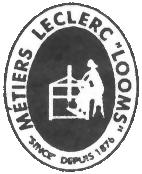
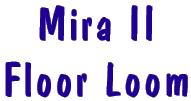


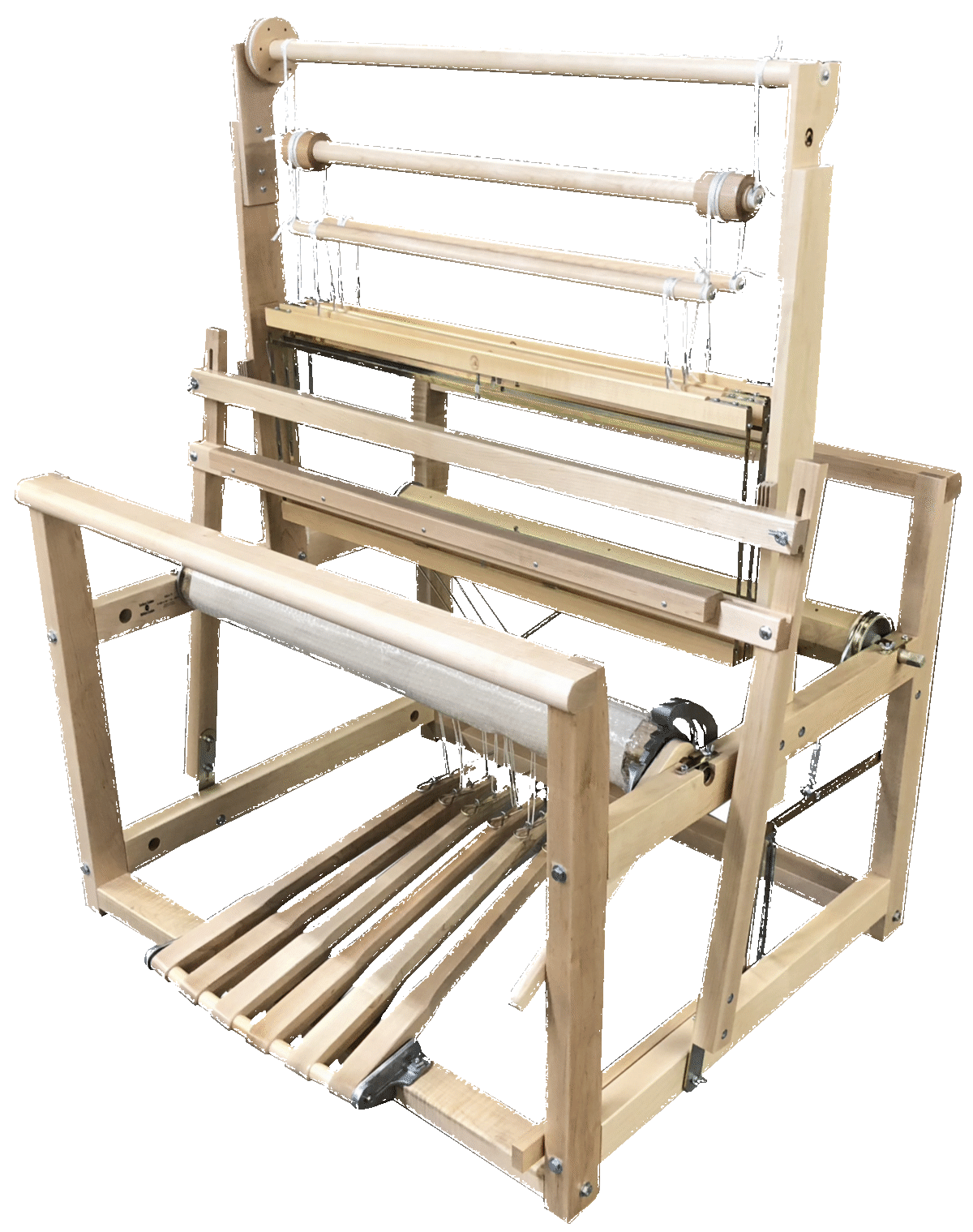
The Mira II is the updated version of the original Leclerc workhorse made for almost a century! This 4 shaft counterbalance loom is perfect for those weavers producing everything from delicate fabrics to high tension weaving projects like rugs and everything in between. It is the perfect four shaft loom for any weaver that wishes the stability this sturdy, rigid frame loom offers. Available in 27, 36, 45 and 60 inch weaving widths, the Mira II also includes Leclerc's exclusive Shed Regulator technology which allows the weaver to switch from balanced to unbalanced weaves with a minimum of adjustment.
Because the loom utilizes a fixed frame design, the Mira II has a larger footprint (loom width x 36 1/2 inch depth) on the floor. This longer depth, solid hardwood construction and the squared frame design gives the loom stability when harder beating is required (ie. rug weaving). The loom is the perfect choice for high volume applications like a commercial production studio or weaving classroom. A flying shuttle beater can be added to speed up production.
The counterbalance shed is wide and clean on every pick for the full range of 4 shaft weaves and the heavy duty cloth beam ratchet mechanism and warp beam friction brake enable the weaver to put a high tension on the warp. Both the breast beams and the cloth beam can be easily removed in a few minutes and optional rakes can be added to the warp beam to turn it into a Sectional Warp Beam. A selection of benches and other accessories are also offered.
Click on the picture of the loom to see a larger version.
| FEATURES | PRICES/SPECIFICATIONS | OPTIONS | DOCUMENTATION | ||
There are a number of superior features built into the Leclerc Mira II looms.
The dimensions and prices for the different Mira II loom widths are listed below:
| Loom | 27" | 36" | 45" | 60" | |
| Ordering Information |
4230-0127 $3,603 CDN $3,314 US |
4230-0136 $3,603 CDN $3,314 US |
4230-0145 $3,823 CDN $3,517 US |
4230-0160 $4,318 CDN $3,972 US |
|
| Heddles (#) | 1,000 | 1,000 | 1,200 | 1,500 | |
| Width | Weaving | 27" (69 cm) | 36" (90 cm) | 45" (115 cm) | 60" (150 cm) |
| Overall | 37" (94 cm) | 46" (117 cm) | 55" (140 cm) | 70" (178 cm) | |
| Depth | 36 1/2" (93 cm) | ||||
| Height | Loom | 58 1/2" (149 cm) | |||
| Breast Beam | 31 1/4" (79 cm) | ||||
| Net Weight | 105 lbs (48 kg) | 113 lbs (51 kg) | 124 lbs (56 kg) | 150 lbs (68 kg) | |
|
|||||
Every Leclerc Mira II loom ordered from Camilla Valley Farm comes complete with the following extras to get you up and weaving immediately:
|
The basic Mira II loom can be customized to fit the weavers application with a number of options. These can be added at the time the loom is purchased or at some point after as the owner's needs change or they expand into other types of weaving:
Double Warp Beam The extra warp beam is easy to install with brackets on the back posts of the loom, and comes with it's own friction brake which can be operated by the weaver sitting at the loom. On floor looms, this feature eliminates the need for the weaver to get up and walk around to the back of the loom to release the tension to advance the warp. The warp threads travelling to the second beam travel over a special secondary thread beam which mounts to the main thread beam and seperates the two warp threads. This beam and the mounting brackets for it are also included. The second warp beam is removable if not in use. |
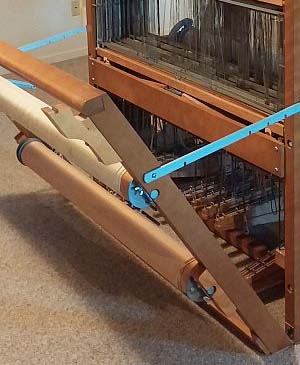 |
Weighted Beater Warp Faced Weaves like Bound and Rep Weave have always presented a challenge to handweavers, especially those using wider floor looms. Rugweavers find the hard beating required to pack the weft is tiring and can cause physical strain on the weaver's wrist and arms reducing the time they can spend at the loom. The Weighted Beater is designed for use with all versions of the Mira II looms Identical in appearance to the standard beater Batten Handtree and Batten Sley included with the Mira II, the Weighted Beater option adds from 4 to 13 pounds (1.8 to 5.9 kgs) to the weight of the beater assembly making it easier for the weaver to beat the weft harder. This Weighted Beater Bar option is used to replace one or both of the horizontal Maple hardwood bars (battens) that hold the reed with similar wood battens containing hidden internal weights. The weights are designed in such a way as to not detract from the looms appearance, damage the loom or get in the way of the weaver. Distribution of the extra weight along the length of the beater, ensures uniform packing of the weft and ensures the battens will not break under the uneven stress found when external weights are simply attached to either end of the beater. Because both Batten Handtree and Batten Sley versions are available, the amount of weight can be varied by using just one or both of these. The regular and weighted battens can be switched easily by undoing two bolts, even when the loom is warped. |
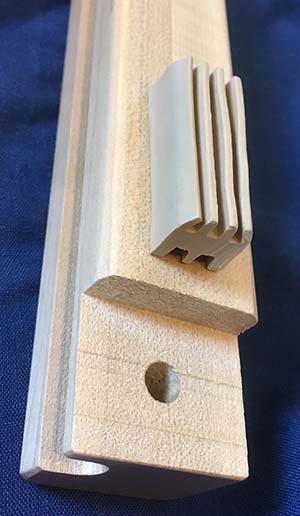 |
Sectional Warping Option 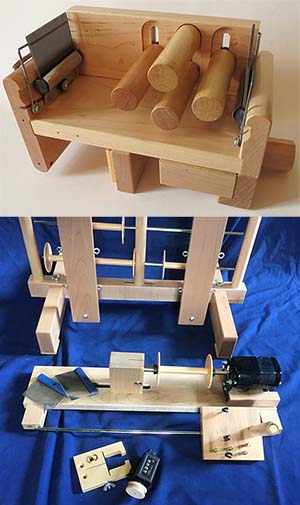
On a sectional beam, the warp can be wound up to the height of the metal clips. To allow for very, very long warps, a set of extensions can also be added to increase the beam diameter and as a result enable a much longer warp to be used. The Mira II warp beam has been positioned with enough space above and below to allow this expansion to occur. In addition to the sectional beam a full Sectional Warping package can be provided including a Tension Box, Warp Counter, Spool Rack, Spools and Electric Winders. Leclerc also makes Dividers, Guides and a Tension Box Extension to help with winding. While a new Mira II owner may not be interested in Sectional Weaving initially, it's nice to know that all the parts and tools are available from Leclerc to transition to this method of warping and that the loom is capable of being used this way. We often hear disappointment from customers who realize that this is not possible on other brands of looms! |
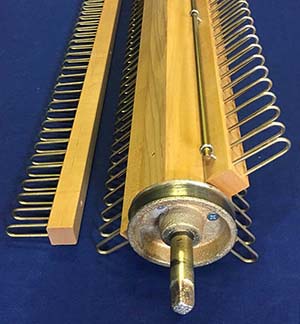
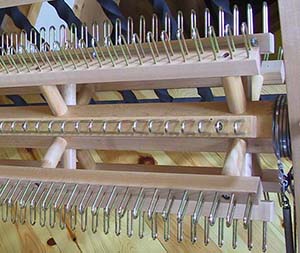 |
Flying Shuttle Option The Flying Shuttle Beater attaches to the standard beater assembly of the Mira II. It consists of a box to hold the shuttle at either end of the beater with a sliding "hammer". A cord is connected from each box to a wooden handle at the center of the loom that the weaver uses to move the "hammer" mechanism. By pulling on the cord, the weaver catapults the shuttle along the reed through the shed until it comes to rest in the shuttle box at the opposite end. After beating the warp and changing the shed, the process is repeated. The shuttle box at each end have a leather strap to catch the shuttle without damaging it. This option includes a special Endfeed Flying Shuttle (EFS) with metal pointed tips that is used in the flying shuttle beater. The Flying Shuttle beater option also includes a wooden Beater Handle that attaches to the Batten Handtree (the top of beater) making it easier for the weaver to grasp the beater. The mechanism is attached to the beater Batten Sley in place of the Shuttle Race, extends out about 16 inches on either side of the loom, and can be easily installed when the weaver wishes to weave with it and removed when they want to throw the shuttle by hand. |
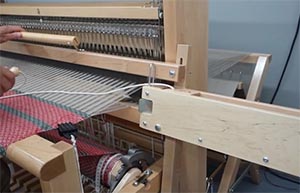
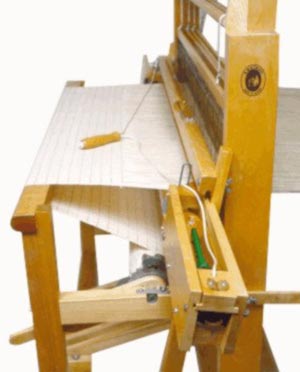 |
Bench Options The basic Fixed Height Bench (top right) provides storage for tools on either side as well as a larger storage area under the hinged seat. This bench has been designed with legs that allow it to be stored out of the way underneath the front breast beam and over the treadles when not in use. An Adjustable Bench (top left) allows the weaver to set the height using removal bolts on each side and pre-drilled holes. Storage can be added to each side using optional canvas bench bags. The Rocking Bench (bottom pictures) is also height adjustable but has a seat that can tilt slightly for comfort. The tilting action can be disabled using a removable bolt provided with the bench. Storage can be added to each side using optional canvas bench bags. |
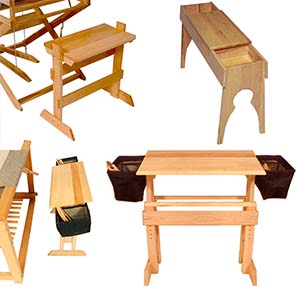 |
| LOOM OPTIONS | ORDERING INFORMATION | ||||
| 36" | 45" | 60" | 72" | ||
| Heddles (Instead of Wire) |
Texsolv |
1024-9836T $114 CDN $105 US |
1024-9845T $130 CDN $119 US |
1024-9860T $172 CDN $158 US |
1029-9872T $206 CDN $190 US |
| Inserted Eye |
1024-9836I $114 CDN $105 US |
1024-9845I $130 CDN $119 US |
1024-9860I $172 CDN $158 US |
1029-9872I $206 CDN $190 US |
|
| Raddle | 6258-4000 $66.00 CDN $61.00 US |
6258-5000 $83.00 CDN $76.00 US |
6258-6000 $99.00 CDN $91.00 US |
Contact Us |
|
| Double Warp Beam | 6432-3000 $677 CDN $623 US |
6432-4000 $775 CDN $713 US |
6430-6000 $898 CDN $826 US |
6430-7200 $984 CDN $906 US |
|
| Sectional Warp Beam Kit | 1 Inch Sections |
6441-4000 $314 CDN $288 US |
6441-5000 $384 CDN $349 US |
6441-6000 $484 CDN $445 US |
6441-7200 $589 CDN $541 US |
| 2 Inch Sections |
6442-4000 $265 CDN $244 US |
6442-5000 $294 CDN $270 US |
6442-6000 $386 CDN $355 US |
6442-7200 Contact Us |
|
| Flying Shuttle Beater | 6471-4000 $1,380 CDN $1,270 US |
6471-5000 $1,380 CDN $1,270 US |
6471-6000 $1,495 CDN $1,375 US |
6471-6072 $1,733 CDN $1,594 US |
|
| Weighted Beater Bar | Top | 1560-3600 $161 CDN $148 US |
1560-4500 $182 CDN $167 US |
1560-6000 $228 CDN $218 US |
1560-7200 $305 CDN $292 US |
| Bottom | 1570-3600 $213 CDN $176 US |
1570-4500 $242 CDN $222 US |
1570-6000 $299 CDN $275 US |
1570-7200 $400 CDN $368 US |
|
| Clip Temple System | 6146-0000 $105 CDN $96 US |
||||
| Rocking Loom Bench (Height Adjustable between 21 and 26 3/4") |
6384-7000 $624 CDN $574 US |
||||
| Open Ended Loom Bench (23" High with open ends for storage) |
6384-2000 $725 CDN $667 US |
||||
Check out our Manual Section for downloadable assembly instructions for this and other Leclerc looms and weaving accessories. Information is also provided on upgrades and accessories. If you are not sure which Leclerc loom you own see our Leclerc Loom Guide to help identify the model.
 |
CAN'T DECIDE? Contact us for help in answering questions about this loom, getting information about others or for help recommending a loom matched to your weaving level and needs. See our Leclerc Loom Comparison Chart for more help in deciding which loom is right for you. |
|
How to Order: Orders may be placed using our secure Online Order Form (this form should open in another window). Click Here for more information on how to place an order as well as our terms and conditions. Payment/Currency: Payment can be made using VISA or Mastercard, Cheque or Money Order in US or Canadian funds. US credit card purchases are billed directly in US funds eliminating any foreign currency conversion charges by the credit card company. Product Directories If you are looking for other items on our website, try using our product directories to quickly find what you are looking for! Our products are grouped as follows: Weaving/Spinning Product Index Books, Magazines & Videos. |
Price/Shipping Quote? If you would like an exact quote for any items complete with shipping costs, please call or email us at nmanners@camillavalleyfarm.com with you location and we will provide this. Gift Certificate If you are looking for a gift for a Knitter or Weaver and can't figure out what they want, a Camilla Valley Farm Gift Certificate is an excellent way to ensure you get the perfect gift! We can also email gift certificates if you are running out of time! Latest News/Updates Keep up to date with what is new at Camilla Valley Farm by following us on Instagram! (Click on the logo below)  |